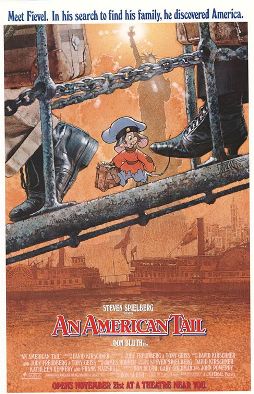Cross-posted from: !animationafter30@lemmy.world
Original thread: https://lemmy.world/post/14414789
Title: An American Tail, and the sequel: An American Tail: Fievel Goes West
Type: Western animated movie
Year: 1986; 1991
Country: United States
Genre: Kids/comedy/action
Appropriate for 30+?: Unable to judge
My rating: N/A
Note: IMO it’s impossible to give a piece of your childhood a fair review (nostalgia and dozens of rewatches heavily warp one’s perception of a work), so I decided to go in a different direction from my typical reviews and focus on the rewatch experience instead.
An American Tail: Fievel Goes West (hereby: FGW) was one of my favorite movies as a young kid. I watched it so many times I could practically recite the dialogue from heart. After learning that it was actually a sequel I watched the original 1986 movie (hereby: AAT) once or twice, but didn’t like it as much. I remember feeling that while the sequel was a laugh-a-minute romp with engaging action scenes, the original just wasn’t as fun and was instead a bit of a downer with some scary/creepy moments (especially the climax when the cats attack and the Mouse of Minsk is released).
Several decades since my last viewing, I decided to give the two movies a watch to see how they held up. I started with AAT and found it somewhat rougher around the edges than I expected, but still above-average for a kid’s movie. I then watched FGW, and wowza I was not wrong as a child: the sequel is such an improvement on the original. It’s the kind of sequel where they basically go through the plot of the original again with a different setting (ala The Hangover), but FGW is such a superior movie that it was more like watching a wildly successful reboot. The animation, soundtrack, pacing, dialogue, humor, and villains experience a huge improvement over the original. There is mild value in watching AAT first (as it explains a few confusing parts of FGW, like why Fievel is willing to risk his life for a hat, and why his father is confident he’ll survive getting lost by himself in the desert), but 99% of FGW stands up on its own.
One major difference between the two is that FGW is infinitely goofier, and is possibly one of the best examples of Looney Tunes-style slapstick humor out there. I haven’t been a fan of slapstick this side of elementary school, and had I had been introduced to these movies as an adult this aspect might have put me off to the sequel, however whether through the power of nostalgia, quality choreography, or the fact that the slapstick is intertwined with other types of humor, I did not mind the slapstick segments much. Additionally, it was quite fun whenever a joke or bit of dialogue came along that made me go, “aha, I’m pretty sure I didn’t catch that as a kid!” I know I didn’t properly appreciate the performances of John Cleese and James Stewart! FGW runs at a mile-a-minute, and there’s so much nonsensically-brilliant dialogue, tight choreography and cinematography, and easy-to-miss details that elevate the movie beyond just a kid-pleasing goofy romp.
I walked away from this exercise in nostalgia relieved that AAT and FGW still hold up over 30 years later (there are some racial stereotypes in both that probably wouldn’t pass muster today, but they’re mild compared to the stuff from that era that didn’t age well). I was impressed with how effortlessly AAT and FGW were able to portray “the American story” in a way easily digestible for young children while still including subtle real-life details (like the pogroms that pushed the Mousekewitz family out of then-Russia-now-Ukraine). I don’t know if an adult watching the movies for the first time would enjoy them, but I definitely had a blast.



These make me cry every time